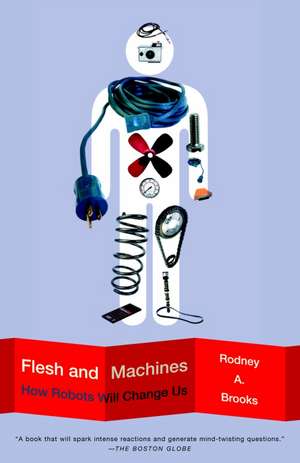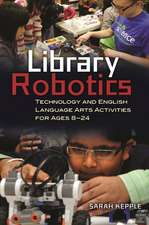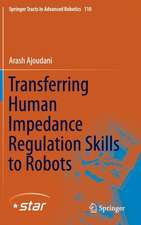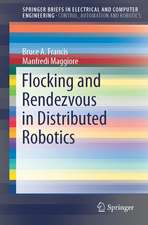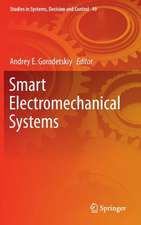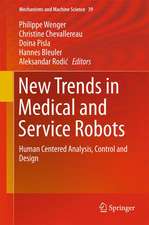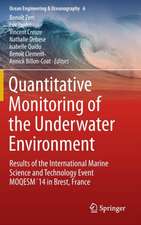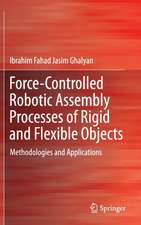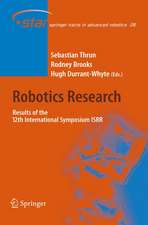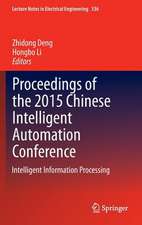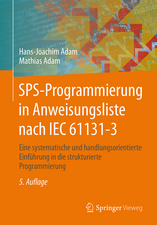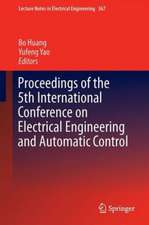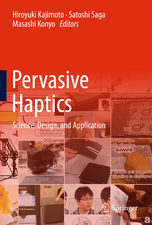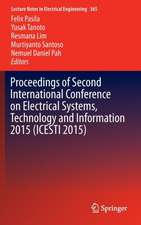Flesh and Machines: How Robots Will Change Us
Autor Rodney A. Brooksen Limba Engleză Paperback – 31 ian 2003
Rodney A. Brooks, director of the MIT Artificial Intelligence Laboratory believes we are. In this lucid and accessible book, Brooks vividly depicts the history of robots and explores the ever-changing relationships between humans and their technological brethren, speculating on the growing role that robots will play in our existence. Knowing the moral battle likely to ensue, he posits a clear philosophical argument as to why we should not fear that change. What results is a fascinating book that offers a deeper understanding of who we are and how we can control what we will become.
Preț: 88.18 lei
Nou
Puncte Express: 132
Preț estimativ în valută:
16.88€ • 17.55$ • 13.93£
16.88€ • 17.55$ • 13.93£
Carte disponibilă
Livrare economică 24 martie-07 aprilie
Preluare comenzi: 021 569.72.76
Specificații
ISBN-13: 9780375725272
ISBN-10: 037572527X
Pagini: 272
Ilustrații: 4 ILLUSTRATIONS
Dimensiuni: 132 x 203 x 15 mm
Greutate: 0.16 kg
Editura: Vintage Books USA
ISBN-10: 037572527X
Pagini: 272
Ilustrații: 4 ILLUSTRATIONS
Dimensiuni: 132 x 203 x 15 mm
Greutate: 0.16 kg
Editura: Vintage Books USA
Notă biografică
Rodney A. Brooks is Fujitsu Professor of Computer Science and Engineering at MIT and director of the Artificial Intelligence Laboratory. He is also chairman and chief technological officer of iRobot Corporation. He is a founding fellow of the American Association for Artificial Intelligence (AAA) and a fellow of the American Association for the Advancement of Science (AAAS). The author of several books and a contributor to many journals, he was one of the subjects of Errol Morris’s 1997 documentary, Fast, Cheap, and Out of Control. Brooks was born in Australia and now lives in suburban Boston.
Extras
1.
Dances with Machines
What separates people from animals is syntax and technology. Many species of animals have a host of alert calls. For vervet monkeys one call means there is a bird of prey in the sky. Another means there is a snake on the ground. All members of the species agree on the mapping between particular sounds and these primitive meanings. But no vervet monkey can ever express to another "Hey, remember that snake we saw three days ago? There's one down here that looks just like it." That requires syntax. Vervet monkeys do not have it.
Some chimpanzees and gorillas have learned tens of nouns, a few adjectives and a few verbs, expressed as signs or symbols. They have sometimes put these symbols together in new ways, like "water bird" to refer to a duck. But they have never been able to say anything as sophisticated as "Please give me the yellow fruit that is in the bag." That requires syntax. Chimpanzees and gorillas do not have it.
Irene Pepperberg has raised and trained Alex, the famous African grey parrot for over twenty years, first at the University of Arizona and more recently at the Massachusetts Institute of Technology (MIT). Her results have been stunning and have rebuffed those who deny that any animals other than humans have any component of language. Alex has forced the naysayers to be much more careful in exactly what capabilities they deny for animals, even birdbrained animals. Alex is able to hear words and speak them. He can answer questions like "How many round green things are on the plate?"–even the first time anyone has ever said the two adjectives "round" and "green" in sequence to him. Alex has been heard to say as his trainer is evidently leaving for lunch, "I'm just going out for lunch and will be back in ten minutes." But this is just Alex parroting (and thus the word) what he has heard the trainer say in these circumstances before. Alex has never said, "I see that you are going out for lunch. I expect you'll be back in ten minutes." That requires syntax. Alex does not have it.
Beavers gnaw down trees to build dams that back up rivers to produce pools where more of the grasses they eat can grow. Birds build nests from twigs, grass stems, and other things they find, such as pieces of wool. But neither of these are technologies in any true sense. If the situations are not completely stereotyped, then the animals are unable to generalize their evolutionarily built-in plan to accommodate the novel circumstances.
Chimpanzees, on the other hand, use different tool sets in different social groupings. The chimpanzees at the Gombe Preserve in Tanzania select long twigs, strip off leaves and protrusions, and then dip them into ants nests and pull out edible ants. The chimpanzees in the Tai Forest of the Ivory Coast do not know how to do this, but unlike those from Tanzania, this social group builds anvils from stumps and rocks, then uses a wooden or rock hammer to break open nuts. The different groups learn how to use these tools within their social groups, but there is very little invention of new tool use. The same tool-use patterns have been observed in the same groups for decades now with no innovations. And no chimpanzees have built tools that have survived over archeological times. Chimpanzees and other animals do not really have anything that remotely suggests human technology.
The only nonhuman tools that we have found preserved have been those of the Neanderthals. The Neanderthals were very close to humans in form, and there are current debates about whether humans and Neanderthals interbred. It is not known whether Neanderthals had language, or syntax, as there is debate over whether they had the vocal tract control necessary for speaking. Perhaps they had syntax in their sign language, as there is in modern sign languages of deaf people. They certainly had technologies to build complex hand tools, weapons, to manipulate fire, make jewelry, and prepare elaborate burial sites. Humans managed to kill off all of that species.
That leaves us humans. We alone on this Earth have syntax, and we alone on this Earth have technology.
For now.
What about our machines? Today there is a clear distinction in most people's minds between the robots of science fiction and the machines in their daily lives. We see 3CPO, R2D2, Commander Data, and HAL in Star Wars, Star Trek, and 2001: A Space Odyssey. But these are not rivaled in any way by the capabilities of our lawn mowers, automobiles, or Windows 2000. There are the machines of science fiction fantasy, and then there are the machines we live with. Two completely different worlds. Our fantasy machines have syntax and technology. They also have emotions, desires, fears, loves, and pride. Our real machines do not. Or so it seems at the dawn of the third millennium. But how will it look a hundred years from now? My thesis is that in just twenty years the boundary between fantasy and reality will be rent asunder. Just five years from now that boundary will be breached in ways that are as unimaginable to most people today as daily use of the World Wide Web was ten years ago.
Throughout the recorded and archeological history of humankind, the way of life that the majority have followed has been dramatically shifted by technological revolutions. Technological revolutions are happening more and more often. The dawn of the most recent of these revolutions, the digital revolution, is within living memory of many of us alive today. The battles and restructuring of our world brought on by the digital revolution is raging around us at its full fury today. It is shifting wealth and power, and restructuring our cities and lifestyles.
We look forward to it running its course, and letting us catch our collective breaths. One wishes it were so simple. No, there is not another technological revolution brewing, about to inundate us with another tsunami that will toss our lives into disarray until we restructure them once again.
There are two. They are about to hit us almost simultaneously.
Technological Revolutions
Since before the start of recorded history technological innovations have transformed our lives as humans. In past times these transformations were gradual and happened over many generations. Now technological innovations can transform our lives many times within a single lifetime.
When I was a teenager, I received all scientific news by way of steamship on a three-month voyage. By 1984 I had cofounded a Silicon Valley company, Lucid, in Palo Alto and taken a position on the faculty at MIT. I was the chief compiler implementor for a Common Lisp product, and I telecommuted from my new home in Massachusetts. First, I used what I now call "Federal Express Net," by which we shipped 20-megabyte tape cartridges back and forth across the country daily by air. Later, I had an expensive leased land line that provided 19.2Kbaud access, and then a little before we arrived at Chapter 11 bankruptcy, I used the free Internet in the early 1990s to telecommute. Thus, I lived through three or four generations of information dispersion technology before I started to feel middle-aged, having experienced the history-in-microcosm of technological life transformations through a series of different machines. While these transformations happened at breakneck speed compared to those that engulfed our ancestors, in my case they were certainly rendered with much less violence or even discomfort. Just as our syntax defines us, so does our technology.
Early in mankind's history, we developed very simple machines, so simple that some people would be hard put to describe them as machines.
A club lets the wielder amplify the velocity of his hand to trade impact force for a reduced duration over what direct pressing of the hand would give. A hand plow concentrates force supplied over a large area to a small area at the point. Pulleys and screws let large and very large forces be applied over short distances by facilitating the hand application of a smaller force over a much longer distance.
All these machines provided physical couplings for transforming forces. All required direct human contribution of force, and all required continuous control by a human to operate. Every second, a human had to be in the loop providing moment-by-moment control to the machine.
By today's standards these early machines were not very complex. But they enabled the first great revolution in the way humans lived their lives. These simple machines enabled the agricultural revolution that began about ten thousand years ago (or 10,000 b.p.–before the present). This, the first of the great revolutions in human life was not at all abrupt; it took thousands of years to spread and become ingrained across the majority of the world's people.
During that transition other critical machines were invented, such as metal smelters and the wheel. The wheel first appeared around 8500 b.p., but it took another three thousand years before animal-drawn vehicles were invented by the Sumerians. With animals pulling them, our machines started to gain some autonomy. No longer did a person have to be in charge moment by moment. Rather, he could give a horse, say, an indication of which way to go, and the horse would handle the low-level details of traversing the ground and would avoid obstacles along the way.
The animal-drawn machines–carts and plows–brought about the second great revolution in human living in about 5500 b.p. The Sumerians were able to drain marshlands, irrigate new land, plow large areas for permanent cultivation, and transport agricultural products. These semiautonomous machines very slightly reduced the total manpower needed to produce food, and let just a few people take on specialized roles, such as priests, charlatans, artists, merchants, and most importantly, rulers. Thus was born the civilization revolution.
The next few thousand years brought incremental changes in technology, including water clocks, windmills, and other simple autonomous machines. These enabled towns and cities to become large, but still the majority of the population lived on farms.
It was not until the invention of the steam engine by Thomas Newcomen in 1705, followed by the replacement of charcoal made from wood with coke made from coal in iron smelters by Abraham Darby in 1709, that the stage was set for the industrial revolution. When James Watt in 1765 added a separate condenser cylinder to Newcomen's later 1712 design, the efficiency of steam engines went way up, and their size ultimately went way down. They were now strong enough to pull themselves around on wheels, and to economically provide energy to mills of all sorts.
The next two hundred years saw a complete remaking of patterns of human settlement. The majority of people moved to towns and cities. They performed two sorts of jobs. Some provided the minute-to-minute intelligence needed to run vast hordes of machines that processed materials into goods. The power systems were autonomous, but the control of the individual machines was not. People filled in the gaps, in autonomy, often in a very mindless, dulling sort of way, repetitively making simple decisions again and again, feeding machines as necessary. The others provided physical labor in places where machines could not do the job. People still loaded and unloaded material from trains, people laid bricks and nailed wooden beams to build houses, people paid attention to individual plants in nongrain agriculture, people washed and cooked, people sorted and redirected goods at all steps in the supply chain, people did all the accounting, banking, and taxing, and people directly controlled the machines of war. In short, people were still required to provide intelligence in environments that were not completely structured for machines.
The industrial revolution continued into the twentieth century, and as fossil-fuel-based power sources got smaller and more efficient, we moved from trains and buses to the individual automobile, which transformed city life first in the Western world and now throughout the world. Our central cities have become places that people go to during the day, and the suburbs have become the places where they go to sleep at night, constrained to be within a manageable commute from their places of work.
The revolutions–agricultural, civilization, and industrial–that we have talked about here did not happen overnight. They were spread over thousands of years initially, down to hundreds of years for the industrial revolution. We are at the tail end of that revolution, but already a visible new revolution has come along. A very different sort of technology is once again transforming our lives. The information revolution, powered by the microcircuit, is changing everything about the way we live. From within, it seems that it is perhaps just a quantitative change, not a qualitative change, but such is the nature of all profound changes that are not also disasters–they happen gradually and one must step outside to see the full dimensions of the changes.
The information revolution has changed our access to knowledge, or content, as it is sometimes called, in ways which may turn out to be more profound than Gutenberg's invention of the movable-type printing press in 1454. That technology enabled distribution of information to the masses and made it worthwhile to learn to read–now there was a constant supply of reading material beyond simple signs to identify a pub or a trading post.
The information revolution started with the invention of the telegraph in 1834. For the first time, information was available instantaneously at a remote location. The telephone democratized this capability, letting untrained people communicate throughout a city instantaneously. With the advent of electronic switches in the second half of the twentieth century, the telephone system was extended throughout the world, and without human help a person was able to dial almost any telephone in the world.
The information revolution is now in full swing, and it is once again transforming our cities. As with all inventions, the World Wide Web is not without its predecessors. In 1945, Vannevar Bush at MIT wrote an article, "As We May Think," in which he discussed possible future technological innovations, many of which have come to pass. Perhaps his most prescient statement was his inkling about computers when he reflected on the reliability of telephone exchanges: "The world has arrived at an age of cheap complex devices of great reliability; and something is bound to come of it."
He also talked about a hypertext knowledge system, called the memex, that might be a desk-sized device. He saw this as the best way to update the methods for disseminating scientific information that had been around largely unchanged for hundreds of years. Starting in the 1960s, Ted Nelson has designed many hypertext systems under the project title Xanadu that would change the way information was stored, referenced, and paid for, but he was not able to get beyond his purity of purpose to a practical distributed implementation. On the other hand, Tim Berners-Lee had to deliver something useful to his employers, and so when he invented the World Wide Web, he straightaway built it and laid it on top of the nascent Internet in the early 1990s. In a lightning-fast spread of the technologies and protocols, the world suddenly had instantaneous availability of almost any information anywhere. We no longer need to travel to the site of information. We can demand, through a few clicks of a mouse button, that it come to us.
This is rapidly changing how much human mediation there needs to be in our access to information. One of the functions left for people in their move to cities during the industrial revolution is being depleted. There is no longer as much need for people in management of the supply chain, and in accounting, banking, and taxing. People are indeed buying books, groceries, appliances, furniture, automobiles, stocks, and travel over the Internet. There is a whole new economy that has formed around online auctions. People who could not afford to sell things before are participating in booming markets for collectible items. They are doing business directly all over the world, without regard to geographical location.
This is already having impact on our cities. As Bill Mitchell, dean of architecture at MIT, likes to point out, the information revolution is converting neighborhood bank branches in U.S. cities into Starbucks coffee stores. It is also having an impact on the way we work–more and more people are now working at home, telecommuting. As higher bandwidths become available, there will be less and less need to be collocated with the place of work, or purchase, and more and more people will move not just tens of miles from their company, but thousands. The constraint of a reasonable commute will be gone and our cities will evolve.
While we are just now heading into the middle of the information revolution, two new revolutions are coming up fast upon us.
The robotics revolution is in its nascent stage, set to burst over us in the early part of the twenty-first century. Mankind's centuries-long quest to build artificial creatures is bearing fruit. Machines are now becoming autonomous in the areas that bypassed them in the industrial revolution. Machines are starting to make the judgments and decisions that have kept people in the loop for the last two hundred years. There will soon be less need for people to engage in the moment-to-moment control of manufacturing machines, and we are starting to see intelligent robots that can operate in unstructured environments, doing jobs that are usually thought to still require people. But these robots are not just robots. They are artificial creatures. Our relationships with these machines will be different from our relationships with all previous machines. The coming robotics revolution will change the fundamental nature of our society.
Hot on the heels of the robotics revolution is the biotechnology revolution. We might think that biotechnology is already here. But we have seen only the merest shadows of its reality. It will transform the technology not just of our own bodies, but also that of our machines. Our machines will become much more like us, and we will become much more like our machines. The coming biotechnology revolution will change the fundamental nature of us.
Further Reading
Bush, V. 1945. "As We May Think." Atlantic Monthly, July. Available online at http://www.isg.sfu.ca/~duchier/misc/vbush/vbush.shtml
Griffin, D. R. 1992. Animal Minds. Chicago: University of Chicago Press.
Hauser, M. D. 1997. The Evolution of Communication. Cambridge, Mass.: MIT Press.
Nelson, T. 1974. Computer Lib/Dream Machines. Peterborough, N.H.: Bits Inc., Rev. ed. published in 1987 by Tempus Books of Microsoft Press, Redmond, Wash.
Pepperberg, I. M. 2000. The Alex Studies: Cognitive and Communicative Abilities of Grey Parrots. Cambridge, Mass.: Harvard University Press.
From the Hardcover edition.
Dances with Machines
What separates people from animals is syntax and technology. Many species of animals have a host of alert calls. For vervet monkeys one call means there is a bird of prey in the sky. Another means there is a snake on the ground. All members of the species agree on the mapping between particular sounds and these primitive meanings. But no vervet monkey can ever express to another "Hey, remember that snake we saw three days ago? There's one down here that looks just like it." That requires syntax. Vervet monkeys do not have it.
Some chimpanzees and gorillas have learned tens of nouns, a few adjectives and a few verbs, expressed as signs or symbols. They have sometimes put these symbols together in new ways, like "water bird" to refer to a duck. But they have never been able to say anything as sophisticated as "Please give me the yellow fruit that is in the bag." That requires syntax. Chimpanzees and gorillas do not have it.
Irene Pepperberg has raised and trained Alex, the famous African grey parrot for over twenty years, first at the University of Arizona and more recently at the Massachusetts Institute of Technology (MIT). Her results have been stunning and have rebuffed those who deny that any animals other than humans have any component of language. Alex has forced the naysayers to be much more careful in exactly what capabilities they deny for animals, even birdbrained animals. Alex is able to hear words and speak them. He can answer questions like "How many round green things are on the plate?"–even the first time anyone has ever said the two adjectives "round" and "green" in sequence to him. Alex has been heard to say as his trainer is evidently leaving for lunch, "I'm just going out for lunch and will be back in ten minutes." But this is just Alex parroting (and thus the word) what he has heard the trainer say in these circumstances before. Alex has never said, "I see that you are going out for lunch. I expect you'll be back in ten minutes." That requires syntax. Alex does not have it.
Beavers gnaw down trees to build dams that back up rivers to produce pools where more of the grasses they eat can grow. Birds build nests from twigs, grass stems, and other things they find, such as pieces of wool. But neither of these are technologies in any true sense. If the situations are not completely stereotyped, then the animals are unable to generalize their evolutionarily built-in plan to accommodate the novel circumstances.
Chimpanzees, on the other hand, use different tool sets in different social groupings. The chimpanzees at the Gombe Preserve in Tanzania select long twigs, strip off leaves and protrusions, and then dip them into ants nests and pull out edible ants. The chimpanzees in the Tai Forest of the Ivory Coast do not know how to do this, but unlike those from Tanzania, this social group builds anvils from stumps and rocks, then uses a wooden or rock hammer to break open nuts. The different groups learn how to use these tools within their social groups, but there is very little invention of new tool use. The same tool-use patterns have been observed in the same groups for decades now with no innovations. And no chimpanzees have built tools that have survived over archeological times. Chimpanzees and other animals do not really have anything that remotely suggests human technology.
The only nonhuman tools that we have found preserved have been those of the Neanderthals. The Neanderthals were very close to humans in form, and there are current debates about whether humans and Neanderthals interbred. It is not known whether Neanderthals had language, or syntax, as there is debate over whether they had the vocal tract control necessary for speaking. Perhaps they had syntax in their sign language, as there is in modern sign languages of deaf people. They certainly had technologies to build complex hand tools, weapons, to manipulate fire, make jewelry, and prepare elaborate burial sites. Humans managed to kill off all of that species.
That leaves us humans. We alone on this Earth have syntax, and we alone on this Earth have technology.
For now.
What about our machines? Today there is a clear distinction in most people's minds between the robots of science fiction and the machines in their daily lives. We see 3CPO, R2D2, Commander Data, and HAL in Star Wars, Star Trek, and 2001: A Space Odyssey. But these are not rivaled in any way by the capabilities of our lawn mowers, automobiles, or Windows 2000. There are the machines of science fiction fantasy, and then there are the machines we live with. Two completely different worlds. Our fantasy machines have syntax and technology. They also have emotions, desires, fears, loves, and pride. Our real machines do not. Or so it seems at the dawn of the third millennium. But how will it look a hundred years from now? My thesis is that in just twenty years the boundary between fantasy and reality will be rent asunder. Just five years from now that boundary will be breached in ways that are as unimaginable to most people today as daily use of the World Wide Web was ten years ago.
Throughout the recorded and archeological history of humankind, the way of life that the majority have followed has been dramatically shifted by technological revolutions. Technological revolutions are happening more and more often. The dawn of the most recent of these revolutions, the digital revolution, is within living memory of many of us alive today. The battles and restructuring of our world brought on by the digital revolution is raging around us at its full fury today. It is shifting wealth and power, and restructuring our cities and lifestyles.
We look forward to it running its course, and letting us catch our collective breaths. One wishes it were so simple. No, there is not another technological revolution brewing, about to inundate us with another tsunami that will toss our lives into disarray until we restructure them once again.
There are two. They are about to hit us almost simultaneously.
Technological Revolutions
Since before the start of recorded history technological innovations have transformed our lives as humans. In past times these transformations were gradual and happened over many generations. Now technological innovations can transform our lives many times within a single lifetime.
When I was a teenager, I received all scientific news by way of steamship on a three-month voyage. By 1984 I had cofounded a Silicon Valley company, Lucid, in Palo Alto and taken a position on the faculty at MIT. I was the chief compiler implementor for a Common Lisp product, and I telecommuted from my new home in Massachusetts. First, I used what I now call "Federal Express Net," by which we shipped 20-megabyte tape cartridges back and forth across the country daily by air. Later, I had an expensive leased land line that provided 19.2Kbaud access, and then a little before we arrived at Chapter 11 bankruptcy, I used the free Internet in the early 1990s to telecommute. Thus, I lived through three or four generations of information dispersion technology before I started to feel middle-aged, having experienced the history-in-microcosm of technological life transformations through a series of different machines. While these transformations happened at breakneck speed compared to those that engulfed our ancestors, in my case they were certainly rendered with much less violence or even discomfort. Just as our syntax defines us, so does our technology.
Early in mankind's history, we developed very simple machines, so simple that some people would be hard put to describe them as machines.
A club lets the wielder amplify the velocity of his hand to trade impact force for a reduced duration over what direct pressing of the hand would give. A hand plow concentrates force supplied over a large area to a small area at the point. Pulleys and screws let large and very large forces be applied over short distances by facilitating the hand application of a smaller force over a much longer distance.
All these machines provided physical couplings for transforming forces. All required direct human contribution of force, and all required continuous control by a human to operate. Every second, a human had to be in the loop providing moment-by-moment control to the machine.
By today's standards these early machines were not very complex. But they enabled the first great revolution in the way humans lived their lives. These simple machines enabled the agricultural revolution that began about ten thousand years ago (or 10,000 b.p.–before the present). This, the first of the great revolutions in human life was not at all abrupt; it took thousands of years to spread and become ingrained across the majority of the world's people.
During that transition other critical machines were invented, such as metal smelters and the wheel. The wheel first appeared around 8500 b.p., but it took another three thousand years before animal-drawn vehicles were invented by the Sumerians. With animals pulling them, our machines started to gain some autonomy. No longer did a person have to be in charge moment by moment. Rather, he could give a horse, say, an indication of which way to go, and the horse would handle the low-level details of traversing the ground and would avoid obstacles along the way.
The animal-drawn machines–carts and plows–brought about the second great revolution in human living in about 5500 b.p. The Sumerians were able to drain marshlands, irrigate new land, plow large areas for permanent cultivation, and transport agricultural products. These semiautonomous machines very slightly reduced the total manpower needed to produce food, and let just a few people take on specialized roles, such as priests, charlatans, artists, merchants, and most importantly, rulers. Thus was born the civilization revolution.
The next few thousand years brought incremental changes in technology, including water clocks, windmills, and other simple autonomous machines. These enabled towns and cities to become large, but still the majority of the population lived on farms.
It was not until the invention of the steam engine by Thomas Newcomen in 1705, followed by the replacement of charcoal made from wood with coke made from coal in iron smelters by Abraham Darby in 1709, that the stage was set for the industrial revolution. When James Watt in 1765 added a separate condenser cylinder to Newcomen's later 1712 design, the efficiency of steam engines went way up, and their size ultimately went way down. They were now strong enough to pull themselves around on wheels, and to economically provide energy to mills of all sorts.
The next two hundred years saw a complete remaking of patterns of human settlement. The majority of people moved to towns and cities. They performed two sorts of jobs. Some provided the minute-to-minute intelligence needed to run vast hordes of machines that processed materials into goods. The power systems were autonomous, but the control of the individual machines was not. People filled in the gaps, in autonomy, often in a very mindless, dulling sort of way, repetitively making simple decisions again and again, feeding machines as necessary. The others provided physical labor in places where machines could not do the job. People still loaded and unloaded material from trains, people laid bricks and nailed wooden beams to build houses, people paid attention to individual plants in nongrain agriculture, people washed and cooked, people sorted and redirected goods at all steps in the supply chain, people did all the accounting, banking, and taxing, and people directly controlled the machines of war. In short, people were still required to provide intelligence in environments that were not completely structured for machines.
The industrial revolution continued into the twentieth century, and as fossil-fuel-based power sources got smaller and more efficient, we moved from trains and buses to the individual automobile, which transformed city life first in the Western world and now throughout the world. Our central cities have become places that people go to during the day, and the suburbs have become the places where they go to sleep at night, constrained to be within a manageable commute from their places of work.
The revolutions–agricultural, civilization, and industrial–that we have talked about here did not happen overnight. They were spread over thousands of years initially, down to hundreds of years for the industrial revolution. We are at the tail end of that revolution, but already a visible new revolution has come along. A very different sort of technology is once again transforming our lives. The information revolution, powered by the microcircuit, is changing everything about the way we live. From within, it seems that it is perhaps just a quantitative change, not a qualitative change, but such is the nature of all profound changes that are not also disasters–they happen gradually and one must step outside to see the full dimensions of the changes.
The information revolution has changed our access to knowledge, or content, as it is sometimes called, in ways which may turn out to be more profound than Gutenberg's invention of the movable-type printing press in 1454. That technology enabled distribution of information to the masses and made it worthwhile to learn to read–now there was a constant supply of reading material beyond simple signs to identify a pub or a trading post.
The information revolution started with the invention of the telegraph in 1834. For the first time, information was available instantaneously at a remote location. The telephone democratized this capability, letting untrained people communicate throughout a city instantaneously. With the advent of electronic switches in the second half of the twentieth century, the telephone system was extended throughout the world, and without human help a person was able to dial almost any telephone in the world.
The information revolution is now in full swing, and it is once again transforming our cities. As with all inventions, the World Wide Web is not without its predecessors. In 1945, Vannevar Bush at MIT wrote an article, "As We May Think," in which he discussed possible future technological innovations, many of which have come to pass. Perhaps his most prescient statement was his inkling about computers when he reflected on the reliability of telephone exchanges: "The world has arrived at an age of cheap complex devices of great reliability; and something is bound to come of it."
He also talked about a hypertext knowledge system, called the memex, that might be a desk-sized device. He saw this as the best way to update the methods for disseminating scientific information that had been around largely unchanged for hundreds of years. Starting in the 1960s, Ted Nelson has designed many hypertext systems under the project title Xanadu that would change the way information was stored, referenced, and paid for, but he was not able to get beyond his purity of purpose to a practical distributed implementation. On the other hand, Tim Berners-Lee had to deliver something useful to his employers, and so when he invented the World Wide Web, he straightaway built it and laid it on top of the nascent Internet in the early 1990s. In a lightning-fast spread of the technologies and protocols, the world suddenly had instantaneous availability of almost any information anywhere. We no longer need to travel to the site of information. We can demand, through a few clicks of a mouse button, that it come to us.
This is rapidly changing how much human mediation there needs to be in our access to information. One of the functions left for people in their move to cities during the industrial revolution is being depleted. There is no longer as much need for people in management of the supply chain, and in accounting, banking, and taxing. People are indeed buying books, groceries, appliances, furniture, automobiles, stocks, and travel over the Internet. There is a whole new economy that has formed around online auctions. People who could not afford to sell things before are participating in booming markets for collectible items. They are doing business directly all over the world, without regard to geographical location.
This is already having impact on our cities. As Bill Mitchell, dean of architecture at MIT, likes to point out, the information revolution is converting neighborhood bank branches in U.S. cities into Starbucks coffee stores. It is also having an impact on the way we work–more and more people are now working at home, telecommuting. As higher bandwidths become available, there will be less and less need to be collocated with the place of work, or purchase, and more and more people will move not just tens of miles from their company, but thousands. The constraint of a reasonable commute will be gone and our cities will evolve.
While we are just now heading into the middle of the information revolution, two new revolutions are coming up fast upon us.
The robotics revolution is in its nascent stage, set to burst over us in the early part of the twenty-first century. Mankind's centuries-long quest to build artificial creatures is bearing fruit. Machines are now becoming autonomous in the areas that bypassed them in the industrial revolution. Machines are starting to make the judgments and decisions that have kept people in the loop for the last two hundred years. There will soon be less need for people to engage in the moment-to-moment control of manufacturing machines, and we are starting to see intelligent robots that can operate in unstructured environments, doing jobs that are usually thought to still require people. But these robots are not just robots. They are artificial creatures. Our relationships with these machines will be different from our relationships with all previous machines. The coming robotics revolution will change the fundamental nature of our society.
Hot on the heels of the robotics revolution is the biotechnology revolution. We might think that biotechnology is already here. But we have seen only the merest shadows of its reality. It will transform the technology not just of our own bodies, but also that of our machines. Our machines will become much more like us, and we will become much more like our machines. The coming biotechnology revolution will change the fundamental nature of us.
Further Reading
Bush, V. 1945. "As We May Think." Atlantic Monthly, July. Available online at http://www.isg.sfu.ca/~duchier/misc/vbush/vbush.shtml
Griffin, D. R. 1992. Animal Minds. Chicago: University of Chicago Press.
Hauser, M. D. 1997. The Evolution of Communication. Cambridge, Mass.: MIT Press.
Nelson, T. 1974. Computer Lib/Dream Machines. Peterborough, N.H.: Bits Inc., Rev. ed. published in 1987 by Tempus Books of Microsoft Press, Redmond, Wash.
Pepperberg, I. M. 2000. The Alex Studies: Cognitive and Communicative Abilities of Grey Parrots. Cambridge, Mass.: Harvard University Press.
From the Hardcover edition.
Recenzii
“A book that will spark intense reactions and generate mind-twisting questions.” -The Boston Globe
“A stimulating book written by one of the major players in the field–perhaps the major player. . . . Offers surprisingly deep glimpses into what it is to be human.” -The New York Times Book Review
“Brooks . . . lucidly explores his life with robots....Flesh and Machines ranges far and wide, but remains unified by the author's passion.”–Wired
“Readers don’t have to share Brooks’ vision of the future to love reading his book, the imaginative work of a skilled yet genial provocateur.”–Pittsburgh Post-Gazette
“Brooks [is] the irrepressible Pied Piper of robotics.” –Los Angeles Times
“A considered and thought-provoking work. . . . This is the best kind of popular science book: The ideas are clear and accessible but not dumbed down.”–American Scientist
“A man-as-machine thesis that is presented accessibly and humanely.” –Booklist
“A stimulating book written by one of the major players in the field–perhaps the major player. . . . Offers surprisingly deep glimpses into what it is to be human.” -The New York Times Book Review
“Brooks . . . lucidly explores his life with robots....Flesh and Machines ranges far and wide, but remains unified by the author's passion.”–Wired
“Readers don’t have to share Brooks’ vision of the future to love reading his book, the imaginative work of a skilled yet genial provocateur.”–Pittsburgh Post-Gazette
“Brooks [is] the irrepressible Pied Piper of robotics.” –Los Angeles Times
“A considered and thought-provoking work. . . . This is the best kind of popular science book: The ideas are clear and accessible but not dumbed down.”–American Scientist
“A man-as-machine thesis that is presented accessibly and humanely.” –Booklist
Descriere
In a clear-sighted look into the technological future, the director of MITUs Artificial Intelligence Laboratory graphically depicts the history of robotic progress while he vividly speculates on a not-too-distant world in which robotic helpers will be able to think, feel, repair themselves, and even reproduce.
